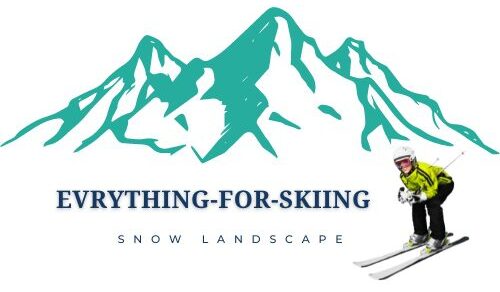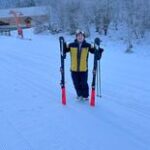Freeride skis are designed for skiing on natural, ungroomed terrains; these skis allow us to explore areas outside marked trails and into off-piste regions. Freeride skis are wider, longer, and heavier than standard skis, which gives better stability and floatation in deep snow and varied conditions like powder and crud. The flexible design lets us handle challenging slopes and adjust to different snow conditions. Freeride skis are also ideal for those who enjoy jumps and big air landings, making them popular among skiers who love the freedom of movement and the excitement of untouched mountain landscapes. Freeride skis are made with solid materials to withstand rugged terrains and provide us with a reliable and thrilling experience for the adventurous.
History of Freeride Skiing
French Origins
The roots of modern freeride skiing can be traced back to the 1930s and 1940s. During this period, pioneers like Émile Allais performed daring descents from some of the most challenging peaks around Chamonix, France. These early skiers pushed the boundaries of possible on the slopes. However, it wasn’t until the 1960s that advancements in ski technology enabled these extreme descents to become more achievable. Developing new equipment and gear was crucial in transforming what was once thought impossible into a reality.
Characteristics of Freeride Skis
Freeride skis are designed for off-piste and backcountry skiing; they have essential features to optimize performance on diverse terrains. With a waist width of 95 to 140 millimeters, these skis excel in flotation, providing stability in deep powder and softer snow conditions. Their rocker-camber-rocker profile, with rockers at the tip and tail and camber underfoot, improves maneuverability and edge grip. This combination lets us control their movements across various snow surfaces, making navigating soft and hard-packed snow easier.
The length of freeride skis often exceeds 180 centimeters, offering increased stability at higher speeds and supporting larger, sweeping turns. Their sidecut radius, typically 18 to 30 meters, ensures stability during big turns, especially on steep or uneven slopes. Additionally, the tip and tail rocker design aids in flotation and turning, making it easier to maintain control in powder and challenging conditions. These features collectively make freeride skis ideal for those who thrive on exploring untouched terrains and mastering varied snow conditions.
Material and Construction of Freeride Skis
The core of freeride skis is made from wood, composites, or metal. Wood cores, like poplar, ash, and paulownia, balance flexibility and durability. Composite materials reduce weight while maintaining strength. Metal cores, such as Titanal, add extra durability, especially in harsh conditions. Freeride skis often use sandwich construction, where layers of materials are bonded together for improved durability and performance.
Freeride skis weigh between 3.5 and 5.5 kilograms (7.7 to 12.1 pounds) per pair. This weight gives us stability on rugged terrain and helps the skis handle off-piste conditions very well.
Wood Types in Freeride Skis
- Poplar: Lightweight and responsive.
- Ash: Adds strength.
- Paulownia: Lightweight and flexible.
Some models include up to 30% carbon fiber, which improves responsiveness and reduces weight. Titanal layers comprise 10-20% of the ski’s materials, increasing strength and stability.
Edge thickness ranges from 2 to 2.5 millimeters, providing resistance to damage from rocks and obstacles. Some skis undergo impact tests to ensure they can endure harsh conditions.
The bases of Freeride skis are typically made from sintered P-Tex. This durable and fast material allows smooth gliding over various snow conditions. Sintered bases also absorb wax better, improving both performance and lifespan.
How Freeride Ski Perform
Freeride skis are designed to excel in various terrains, including soft and fresh snow, making them ideal for fast skiing, hitting jumps, and landing giant airs. These skis are generally wider, longer, and heavier than typical skis, which enhances their ability to perform well in challenging conditions. Depending on the model, freeride skis can vary significantly:
- Smooth-running: Built for long, fast descents, allowing skiers to maintain speed and stability.
- Agile: Designed for performing tricks and having fun on varied terrain.
- Lighter models: Easier to climb with, making them suitable for touring.
- Heavier models: Provide better edge grip on challenging slopes.
Freeride skis typically have a flex rating between 6 to 9 on a scale of 1 to 10, with 10 being the stiffest. This balance between flexibility and stiffness ensures responsiveness and control, essential for navigating off-piste conditions. Usually 88 or 89 degrees, the edge angle delivers strong edge hold and precise control, especially on complex and variable snow surfaces.
Freeride skis incorporate vibration-dampening layers made from materials like rubber or urethane to reduce vibrations, improving comfort and control. Their turn radius is engineered for long, sweeping turns, enhancing stability and flow across diverse terrains.
Additionally, freeride skis feature a structured base grind pattern, such as crosshatch or linear designs. This pattern reduces friction and enhances speed and control, particularly in powder and mixed snow conditions.
Design and Sustainability Features of Freeride Skis
Features of Freeride skis like spoon or blunt tip shapes improve flotation and control in powder. Flat or slightly raised tails add stability and versatility in different snow conditions. The twin-tip design allows skiing backward (switch) and improves maneuverability in tight spaces. The binding mounting point is usually 2 to 3 centimeters behind the center, which increases flotation in deep snow and maintains control on steep terrain.
Modern freeride skis also emphasize environmental sustainability. Many brands use up to 50% recycled materials and reduce their carbon footprint by utilizing renewable energy sources and non-toxic, water-based inks for graphics. A water-repellent top sheet prevents snow buildup, keeping the skis lightweight. UV-protected graphics ensure durability and maintain aesthetics. Additionally, some models are compatible with climbing skins, making backcountry access and uphill travel easier.
Detailed Comparison of Freeride, All-Mountain, Freestyle, and Backcountry Skis
Below is a detailed comparison of freeride skis with all-mountain, freestyle, and backcountry skis, covering various performance attributes, design features, and intended use.
Comparison of Ski Types
| Feauters | Freeride Skis | All-Mountain Skis | Freestyle Skis | Backcountry Skis |
|---|---|---|---|---|
| Waist Width | 95-140 mm | 85-100 mm | 85-100 mm | 85-110 mm |
| Rocker Profile | Rocker-Camber-Rocker | Rocker-Camber-Rocker or Flat-Camber | Twin Rocker or Full Camber | Rocker-Camber-Rocker |
| Flex | Medium to Stiff | Medium | Soft to Medium | Medium |
| Length | 180+ cm | 160-180 cm | 150-170 cm | 160-180 cm |
| Turn Radius | 18-30 meters | 15-20 meters | 10-15 meters | 15-25 meters |
| Tip Shape | Spoon or Blunt Tip | Moderate Taper | Symmetrical Tip and Tail | Slightly Tapered or Blunt |
| Tail Shape | Flat or Slightly Raised | Flat or Slightly Raised | Twin Tip | Flat or Slightly Raised |
| Twin Tip Design | Sometimes | Rarely | Always | Rarely |
| Torsional Rigidity | High for edge holds | Moderate | Low to Moderate | High for stability |
| Vibration Dampening | Rubber or Urethane Layers | Minimal | Minimal | Rubber or Urethane Layers |
| Weight | Heavier for stability in varied terrain | Moderate | Lightweight for agility | Lightweight for uphill efficiency |
| Intended Terrain | Off-Piste, Backcountry | Groomed and Ungroomed Terrain | Parks, Pipes, and Groomed Runs | Off-Piste, Touring, and Backcountry |
Comparison Analysis with All-Mountain, Freestyle, and Backcountry Skis
Freeride vs. All-Mountain Skis
Freeride skis are wider, with a waist width ranging from 95 to 140 mm, designed for off-piste performance. This wider profile allows better flotation on powder snow, providing stability in deeper conditions. In contrast, all-mountain skis have a narrower waist width, between 85 to 100 mm, offering versatility on both groomed and ungroomed terrain. Freeride skis often exceed 180 cm in length for stability at higher speeds, while all-mountain skis range from 160 to 180 cm, balancing maneuverability and control on various terrains.
The rocker-camber-rocker profile of freeride skis improves flotation and edge hold in different snow conditions. All-mountain skis may have a similar profile but are generally designed for better performance on groomed trails. Freeride skis have a turning radius of 18 to 30 meters, suited for long, sweeping turns, whereas all-mountain skis have a tighter turn radius of 15 to 20 meters, making them more responsive for short turns on mixed terrain.
Freeride vs. Freestyle Skis
Freestyle skis are designed for park and trick skiing. They feature a softer flex and a twin-tip design for skiing backward (switch). Their waist width is narrower, between 85 and 100 mm, optimizing agility over flotation. Freestyle skis are shorter, ranging from 150 to 170 cm, enhancing maneuverability in tight spaces like parks and half-pipes.
In contrast, freeride skis focus on stability and performance in varied snow conditions, with a medium to stiff flex for better edge hold and control in off-piste environments. While both ski types may feature a twin-tip design, it is standard in freestyle skis for trick skiing and optional in freeride skis.
Freeride vs. Backcountry Skis
Backcountry skis prioritize lightweight construction for efficient uphill travel. They are generally lighter than freeride skis, sacrificing some downhill stability for easier ascents. Freeride skis are heavier, focusing on downhill performance with stability and control in variable snow conditions. Both ski types feature a rocker-camber-rocker profile, but backcountry skis often have a narrower waist width of 85 to 110 mm, reducing weight and improving uphill maneuverability.
The turn radius of backcountry skis ranges from 15 to 25 meters, providing a balance between stability and quick turning, essential for navigating unpredictable terrain. Freeride skis have a larger turn radius of 18 to 30 meters, optimized for big turns in open, off-piste areas.
Freeride skis are tailored for off-piste and backcountry skiing, with a wider waist width, stiffer flex, and a larger turn radius for stability and control. All-mountain skis are versatile for both groomed and ungroomed terrain. Freestyle skis specialize in park and trick skiing with a softer flex and twin-tip design. Backcountry skis focus on lightweight construction for efficient uphill travel while offering features for downhill performance. Each ski type has specific attributes to meet different skiing styles and terrain needs.
Conclusion
Freeride skis are the perfect choice for those who seek adventure beyond the groomed trails. Their broader and heavier design provides excellent stability and floatation, making them ideal for deep snow and varied conditions. Freeride skis are built to handle rugged terrain and big air landings, offering reliability and excitement. For those who love the freedom of exploring untouched mountain landscapes, freeride skis ensure a thrilling and dependable skiing experience.

